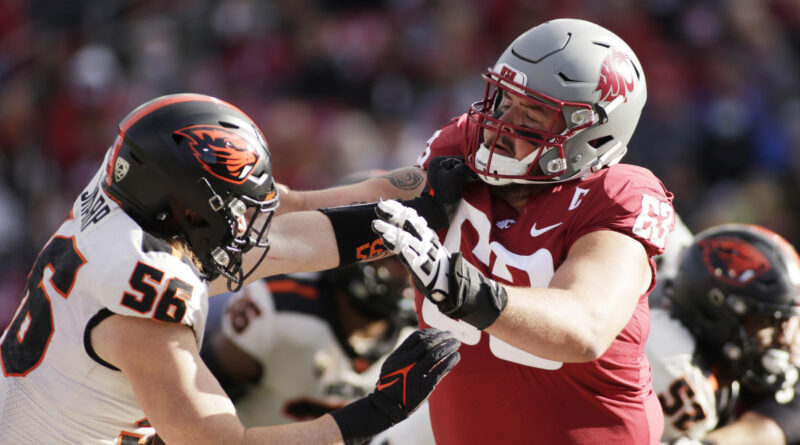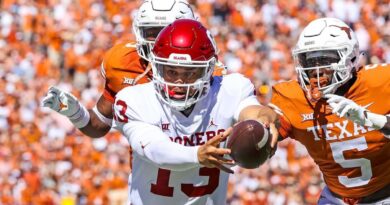Sources: MWC, AAC ramp up courtship of Oregon State and Washington State with college landscape still shifting
The Mountain West and American Athletic Conference are revving up their expansion engines.
Commissioners of those leagues, Gloria Nevarez (MWC) and Mike Aresco (AAC), will deliver expansion presentations in the coming days to officials from Washington State and Oregon State, sources tell Yahoo Sports — the first serious step in the two conferences’ courtship of the Pac-12’s remnants.
The MWC and AAC’s pursuit of the Cougars and Beavers is accelerating as ACC discussions with Stanford and Cal intensify. Left homeless when the Pac-12 broke apart earlier this month, Oregon State and Washington State now find themselves in the midst of a conference tussle for their services — the latest two dominoes in the most significant realignment wave in the industry’s history.
Nevarez, in her first year as MWC commissioner and herself a former Pac-12 conference administrator, made her first presentation Thursday, appearing in person before a Washington State expansion advisory committee led by WSU president Kirk Schulz. She is expected to present to Oregon State officials in the coming days.
Aresco, a former television executive in his 12th year as a commissioner, will soon present virtually in separate meetings with WSU and OSU administrators.
Each commissioner will detail his and her league’s strengths. No decisions or commitments from the schools are expected, as both continue to wait for a final resolution to Stanford and Cal’s pursuit of ACC membership — something expected within the next several days.
The ACC’s decision will impact the future and existence of the Pac-12. Without Stanford and Cal, Oregon State and Washington State have limited options. The thought of rebuilding the conference — already a high hurdle — is made even more difficult without a brand like Stanford.
It leaves the two schools drifting afloat without a home — or a television contract — beyond this coming June. The MWC and AAC are actively entertaining their additions. While residing in remote, small markets, the two programs are attractive. For one, they bring Power Five resources and potentially additional value in future television deals.
In an expanded 12-team playoff, the Group of Five is guaranteed at least one automatic qualifying spot. The two additions are also seen as a way to bolster each conference’s CFP chances.
Since the Pac-12 breakup three weeks ago, administrators from the two schools have communicated with officials in the MWC and AAC. Conversations within the Mountain West have mostly centered on two options: (1) simply acquiring OSU and WSU under the MWC umbrella and dissolving the Pac-12; or, (2) a full merger with the two schools under the Pac-12 banner in an effort to preserve that brand.
A merger is a more complicated endeavor, but could bring with it Pac-12 cash as well as Pac-12 problems.
The league has millions coming to it in NCAA men’s basketball tournament revenue. Each conference receives NCAA tournament monetary units based on how many games a team from that league advanced in the event. It is a rolling six-year system, meaning that the Pac-12 has units of pay coming from teams, even those leaving, that played in the last six NCAA tournaments.
A source with knowledge estimated the total amount for the conference to be roughly $1src million to $15 million per year. But there are legal questions on the distribution of money earned from departing schools.
There are plenty of problems.
The conference is without a television contract, and it is saddled with legal issues, including an NLRB employment claim; lawsuits from the Holiday Bowl and two former employees; and more than $5src million owed to Comcast for an accounting error.
A rebuilt Pac-12 will almost certainly lose two designations — one from the NCAA and one from the CFP: (1) the autonomous-five governance status that grants them more authoritative powers in rule-making; and (2) the Power Five status with the CFP that grants those leagues more revenue in the playoff distribution model.
While geographically a merger or entrance into the Mountain West is more sensible, the American offers a potentially more lucrative package. Through its partnership with ESPN, AAC teams earn an average of about $8 million to $9 million in annual distribution. In their deal with CBS Sports Network and Fox, MWC teams earn about $5 million to $6 million.
The American’s TV contract runs through the 2src31-32 academic year. The Mountain West’s TV deal ends after the 2src25-26 season. TV contracts are the primary revenue source for schools. In either scenario, Oregon State and Washington State stand to lose more than $2src million in annual TV revenue because of the Pac-12’s breakup.
For the two schools, time is precious. They have likely scheduled just six football games next season: three non-conference games, one against the other and, presumably, one each against Stanford and Cal.
Since the Pac-12’s breakup, the four remaining Pac-12 schools have occasionally met while Stanford and Cal pursued ACC and Big Ten membership. Publicly and privately, Washington State and Oregon State steered conversations toward rebuilding the league by adding American and Mountain West programs.
The NCAA requires eight members to be recognized as an FBS conference, but there is a grace period of two years. According to NCAA bylaw 2src.src2.9.2, a conference shall continue to be considered an FBS league for two years after it drops below the eight-team threshold.
Uncommitted to such a rebuilding plan, the Cardinal and Bears continued to look elsewhere, even proposing to take a significantly reduced share from the ACC, a change that has intensified talks in the conference about seriously adding the two schools as well as SMU.



